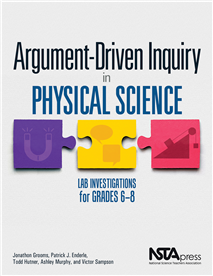Argument-Driven Inquiry in Physical Science
By Carole Hayward
Posted on 2016-12-23
Interested in teaching your students how to make and support their science explanations in the classroom? We’ve got just the thing. The newest books in the Argument-Driven Inquiry Series from NSTA Press is here.
 Argument-Driven Inquiry in Physical Science Lab Investigations for Grades 6-8 and the accompanying student manual offer 22 labs that align with the recommendations of A Framework for K-12 Science Education, as well as the Common Core State Standards for English Language Arts and Mathematics.
Argument-Driven Inquiry in Physical Science Lab Investigations for Grades 6-8 and the accompanying student manual offer 22 labs that align with the recommendations of A Framework for K-12 Science Education, as well as the Common Core State Standards for English Language Arts and Mathematics.
The labs provide students with the independence to investigate, analyze, and determine a conclusion. Labs include “Mass and Motion: How Do Changes in the Mass of an Object Affect Its Motion?” In the lab, students will study the motion of a pull cart to investigate what makes a system stable and what causes changes within a system, and then draw conclusions from patterns they observe.
The lab “Kinetic Energy: How Do the Mass and Velocity of an Object Affect Its Kinetic Energy?” asks students to use what they know about force and motion, patterns, and causal relationships to design and carry out an investigation and create a mathematical model explaining the relationship between mass, velocity, and force of impact.
With the argument-driven inquiry model students are asked to give presentations to their peers; respond to questions; and write, evaluate, and revise reports as part of each lab. The model is designed to be thought-provoking and multi-layered. Students must identify the task and guiding question, design a method and collect data, analyze data to develop an argument, and more.
“Each of the eight stages in the argument-driven inquiry instructional model is designed to ensure that the experience is authentic (students have an opportunity to engage in the practices of science) and educative (students receive the feedback and explicit guidance that they need to improve on each aspect of science proficiency),” the authors write in the first chapter.
Check out the free sample lab “Potential Energy: How Can You Make an Action Figure Jump Higher?” from Argument-Driven Inquiry in Physical Science: Lab Investigations for Grades 6-8 by Jonathon Grooms, Patrick J. Enderle, Todd Hutner, Ashley Murphy, and Victor Sampson.
You can also get the accompanying student lab manual for grades 6-8 here. Explore other books in the Argument-Driven Inquiry Series, including volumes focused on life science, biology, and chemistry.
Follow NSTA
Save
Disclaimer: The views expressed in this blog post are those of the author(s) and do not necessarily reflect the official position of the National Science Teaching Association (NSTA).


